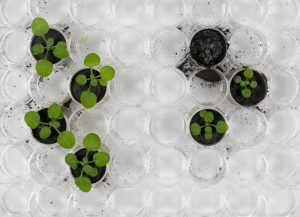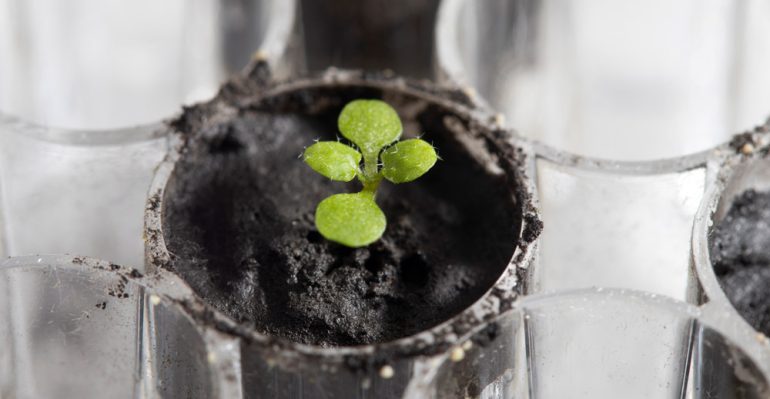Mixed results: For the first time ever, terrestrial plants have grown on real lunar material — samples of lunar dust from the Apollo missions. Plants actually developed from seeds on regolith enriched with nutrient solution. However, the plants were smaller, their leaves had discolored and their gene activity also indicated massive stress responses. So the cultivation of plants on lunar land is theoretically possible, but difficult.
There will be astronauts in the near future return to the moon and there possibly even permanently lunar station to erect. However, for such colonization of the Earth’s satellite there are sufficient resources – water, oxygen and energy must be obtained at the site. The same applies to the food supply, especially with plants.

Plants for future lunar colonies
Scientists have been testing how vegetables and co-workers have been growing under lunar and Martian conditions over a long period of time. hydroponic greenhouse among other things in the Antarctic, but also with Regolith Analogs, These include volcanic sands from Hawaii, which have sharp-edged grains and mineral compositions similar to those of the lunar subsoil. In fact, tomato, lettuce and co grew relatively well on such analogs – but would this also apply to real lunar regolith?
Anna-Lisa Paul from the University of Florida in Gainesville and her colleagues have now tested this: They were the first research team to have a chance to do so. real moon material From the pool of the Apollo missions. Samples of the Moon brought to Earth by NASA astronauts nearly 50 years ago are still extremely valuable for planetary research and are therefore only made available for a select few tests.
First test with Apollo Moondust
But after an eleven-year wait, Paul and his team finally got lucky: They found twelve grams of moon dust for their planting experiments. The samples came from three different lunar missions: The regoliths of Apollo 11 and 12 were briefly exposed to the harsh radiation of the lunar surface and therefore “ripened” chemically and physically, as the team explains. On the other hand, the Apollo 17 samples contained “immature” lunar dust from sample sites protected from space weathering.
For their tests, the researchers had to use valuable material sparingly: They used tiny indentations in a plastic tray commonly used as “flower pots” for cell culture tests. They filled a gram of regolith in each of these depressions, moistened it with a nutrient solution and added seeds of thalli cress (Arabidopsis thaliana) – a proven and genetically well-studied experimental plant. The JSC-1A regolith analog developed by NASA serves as a control.

Germination function, development only to a limited extent
It was found that all seeds germinated between 48 and 60 hours after planting and developed normal stems and cotyledons in lunar planting. “We were surprised, we didn’t expect it,” Paul says. “This shows us that lunar soil does not inhibit plant germination signals and hormones.” In the further course, all the plants grew and developed roots and more leaves.
After a few days, however, the first difference became apparent: “Compared to the JSC-1A analog, lunar plants took longer to reveal their leaves, had smaller leaf rosettes and some very few and heavily pigmented were – this is a common indicator for plant stress of plants,” the researchers report. Instead of the usual green color, plants growing on the lunar regolith were red and brown.
Test plants on the Apollo 11 samples were most affected, the team reports, but development was slightly better on the low-weather lunar material from the Apollo 17 samples.
marked genetic stress response
To learn more about the causes of the impaired growth, Paul and his colleagues analyzed the gene activity of the test plants. Here, too, there were clear differences in the regolith analogs: in plants growing on lunar material, hundreds of genes specific to high stress loads were active. “71 percent of these genes are associated with exposure to salts, metals and highly reactive oxygen compounds,” report the researchers.
This genetic stress response also showed a graded response to different “mature” lunar regoliths: plants on the Apollo 11 substrate activated 465 stress-related genes, while Apollo 12 plants activated them on slightly shorter-season lunar dust. did es 265 and apollo-17 113 stress genes. “This suggests that the plant’s response also depends on the type of regolith,” Paul and his colleagues wrote.
Cultivating the Moon Crop – Possible, But Difficult
Overall, the results suggest that plants could, in theory, grow on lunar dust if it was enriched with a nutrient solution. “However, the lunar regolith is not a very plant-friendly growth substrate,” the team says. Even plants that are still growing fairly well show clear signs of high stress levels. More research needs to be done on how and if this can be compensated.
Another finding: If you install a lunar greenhouse, you should use regolith that is as “immature” as possible and has little exposure to radiation. Because the chemical-physical changes that accumulate on the surface of the Moon over time appear to be particularly unpleasant for terrestrial plants.
However, it is not clear whether plants can withstand the high radiation exposure on the surface of the Moon. Chinese lunar lander Chang’e 4 did it in 2019 successful germination Detected by test plants in the accompanying germination container. earth evolution test under increased radiation However, it has been shown that this inhibits growth and puts pressure on plants. (Communication Biology, 2022; DOI: 10.1038/s42003-022-03334-8,
Source: University of Florida

Internet fan. Alcohol expert. Beer ninja. Organizer. Certified tv specialist. Explorer. Social media nerd.





